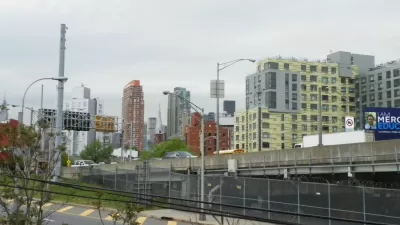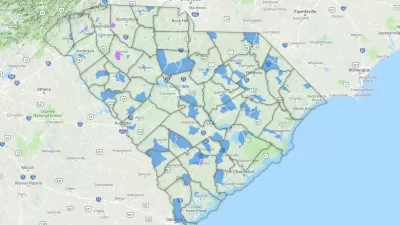Two recent studies are among the first to attempt a comprehensive account of the effects of the Investing in Opportunity Program, one of the signature place-based policies of the Trump era.

The GOP tax bill of 2017, one of the signature legislative achievements of the Trump administration was signed into law a little over five years ago. Long-time Planetizen readers will recall that the tax bill included the landmark Investing in Opportunity Act, which changed the economics of redevelopment and revitalization by creating tax breaks for development in Opportunity Zones decided at the state level. Proponents of the program lobbied for the program as a new way to incentivize development in low-income, underserved neighborhoods.
The Opportunity Zones program also created all sorts of controversy as states decided which communities should be included and the money started to roll out, especially as gentrifying neighborhoods and wealthy developers reaped funding from the program and critics lobbed accusations of abuse.
Given the recent five-year anniversary of the adoption of the program, it’s no surprise to see two recent studies into the effects of the program published by researchers:
- A November 2022 research paper authored by two economists with the U.S. Department of the Treasury, David Coyne and Craig Johnson, uses preliminary IRS data for tax years 2018 through 2020 to provide a survey of the amount and reach of early Opportunity Zones investment.
- A November 2022 working paper by University of California-Berkeley economist Harrison Wheeler, uses building permits data to document whether the incentive elicited a development response in and around communities designated as Opportunity Zones.
A recent article published by the organization that originated the Investing in Opportunity Act, the Economic Innovation Group, spreads the word about the new studies, summarizing the research findings as follows: “While many questions remain unanswered, the emerging evidence suggests that Opportunity Zones have already achieved a combination of expansive geographic reach, large-scale private investment, and significant economic effects that is unique in the history of U.S. place-based policy.”
A few headliners among the data called out by the Economic Innovation Group:
- OZ investment reached approximately 3,800 communities from mid-2018 through 2020.
- Total OZ equity investment was at least $48 billion by the end of 2020.
- In addition to boosting the supply of housing, OZ designations improved local home values by 3.4 percent from 2017 to 2020 with no observed increase in rents.
More details on the Economic Innovation Group’s take (the obvious caveats about their conflict of interest on the issue apply) on the findings of the two studies are available at the source article below.
FULL STORY: Examining the Latest Multi-Year Evidence on the Scale and Effects of Opportunity Zones Investment

Planetizen Federal Action Tracker
A weekly monitor of how Trump’s orders and actions are impacting planners and planning in America.

Congressman Proposes Bill to Rename DC Metro “Trump Train”
The Make Autorail Great Again Act would withhold federal funding to the system until the Washington Metropolitan Area Transit Authority (WMATA), rebrands as the Washington Metropolitan Authority for Greater Access (WMAGA).

The Simple Legislative Tool Transforming Vacant Downtowns
In California, Michigan and Georgia, an easy win is bringing dollars — and delight — back to city centers.

The States Losing Rural Delivery Rooms at an Alarming Pace
In some states, as few as 9% of rural hospitals still deliver babies. As a result, rising pre-term births, no adequate pre-term care and "harrowing" close calls are a growing reality.

The Small South Asian Republic Going all in on EVs
Thanks to one simple policy change less than five years ago, 65% of new cars in this Himalayan country are now electric.

DC Backpedals on Bike Lane Protection, Swaps Barriers for Paint
Citing aesthetic concerns, the city is removing the concrete barriers and flexposts that once separated Arizona Avenue cyclists from motor vehicles.
Urban Design for Planners 1: Software Tools
This six-course series explores essential urban design concepts using open source software and equips planners with the tools they need to participate fully in the urban design process.
Planning for Universal Design
Learn the tools for implementing Universal Design in planning regulations.
Smith Gee Studio
City of Charlotte
City of Camden Redevelopment Agency
City of Astoria
Transportation Research & Education Center (TREC) at Portland State University
US High Speed Rail Association
City of Camden Redevelopment Agency
Municipality of Princeton (NJ)





























